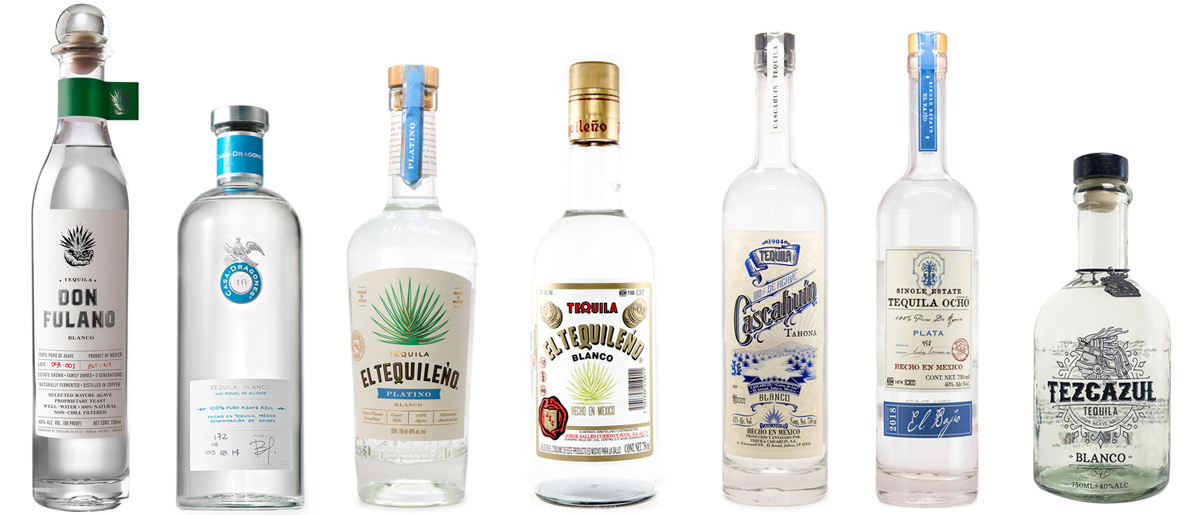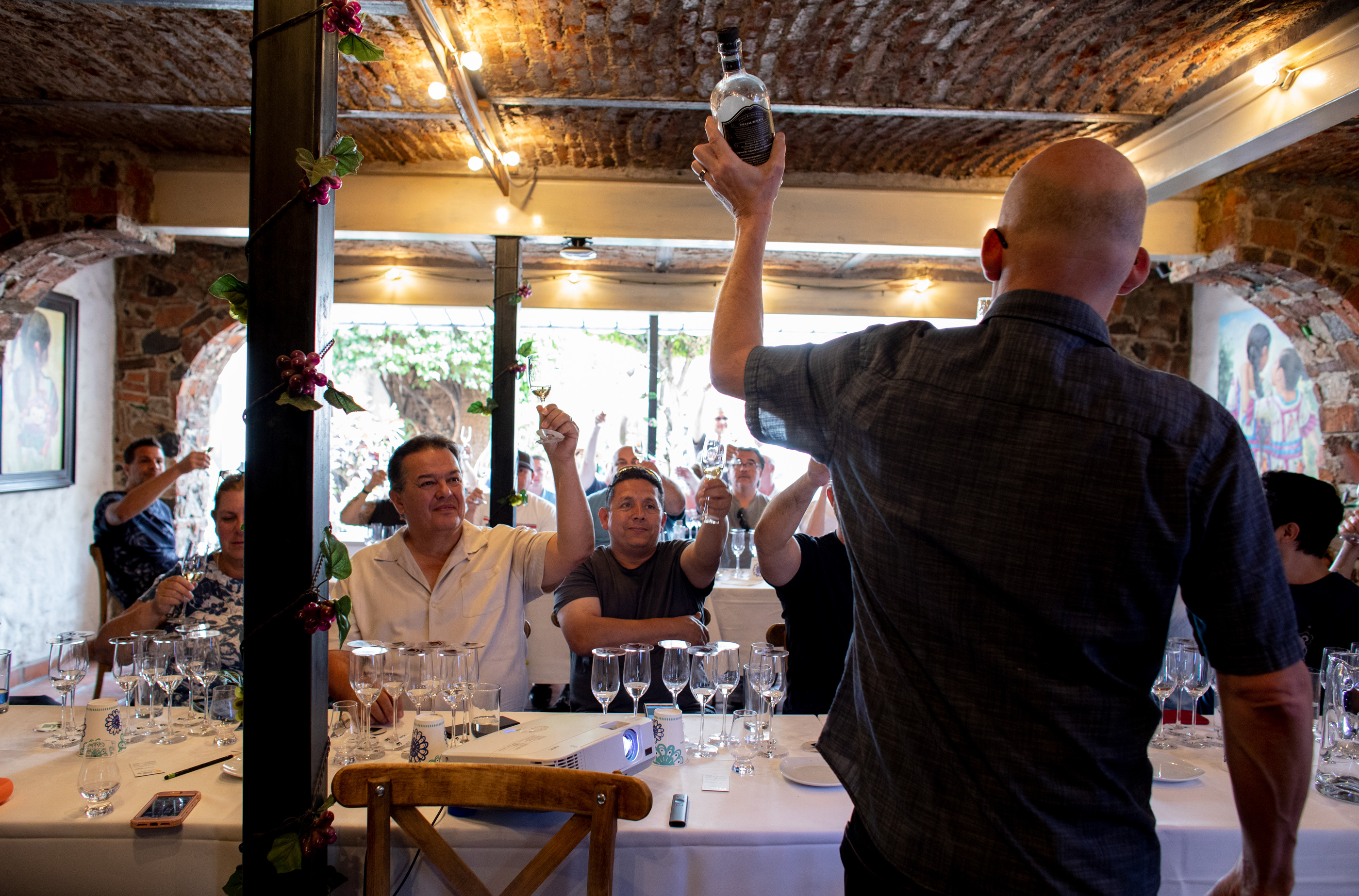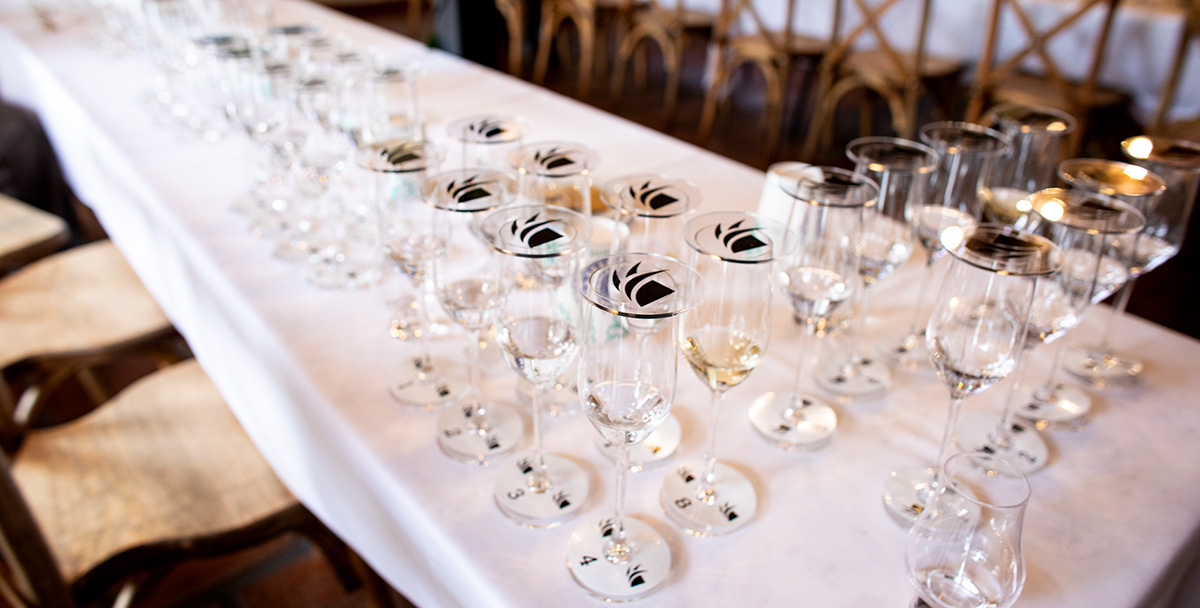When’s the last time you were surprised by your own palate? It’s probably been a while. That’s because we tend to gravitate toward the foods, flavors and brands that we are familiar with. The problem with this approach is that we rarely get beyond our known preferences. That’s why, when it comes to tequila, we love to do blind tastings. Suddenly, all the preconceived notions you get from the bottle, the marketing, your past experiences with the brand, or your own personal relationships, are stripped away. It’s just the juice in the glass and your senses.
We find the blind tasting experience so valuable that we’ve developed a mobile app interface that leads people through a blind ratings experience, with group results revealed the instant the tasting is done.
Last month we kicked off the first in what will be a series of monthly public blind tasting events at the Quinta Don Jose Boutique Hotel in Tlaquepaque. As usual, the results were surprising, especially given that the majority of this group were long-time aficionados, so they already had a good idea of the tequila and brands that they preferred.
Here are the 7 blancos we chose for the lineup:

-
Don Fulano Blanco
Casa Dragones Blanco
El Tequileño Platino Blanco
El Tequileño Blanco
Cascahuín Tahona Blanco
Ocho Tequila Plata – el Bajío 2018
Tezcazul Tequila Blanco
The 33 participants rated them blind using a special area of the Tequila Matchmaker app.
Let’s get into the results. Our tasting events are designed in a way that makes them more than just a contest among brands, so before we get into that, we talk about process. By averaging the overall scores (including points for aroma, flavor, finish, and value) we can show which production methods people liked (and disliked) the most. We can discover this, thanks to all the process data packed into the app.
We look at:
Cooking/Hydrolysis: How the sugar conversion is made…
Participants in this blind tasting preferred high pressure autoclaves and stone/brick ovens the most, while low pressure autoclaves scored slightly above average. But the lowest, by far, was the one most commonly used with diffuser production.

Extraction: How the sugars are removed from the agave fibers…
The most traditional of extraction processes scored highest with this group. The tahona, which is a 2-3 ton stone wheel used to squeeze the sugars off of the cooked agave fibers, finished just above the more modern roller mill. The screw mill finished slightly above average. Diffuser extraction finished last.

Distillation: The type of still used…
Stainless Steel stills with copper coils and copper pot stills scored the highest points. The combination of copper pot and column still clocked in a touch above average. And full column still production scored the lowest.

If you’re curious about why these average scores are so low, it’s because they were rated blind. People *always* rate tequila lower when they don’t know what they are rating. We’ve seen people rate their favorite tequilas much lower than normal simply because it was blind. This is proof that the bottle design, brand story, and personal relationships contribute significantly to a person’s idea of what they are tasting. This tends to be the biggest surprise for people who participate in our blind tastings.
In summary, when tasted blind, this group of serious tequila aficionados preferred traditionally made tequilas over the modern, mass production diffuser style.
Now let’s talk about the brands…
So, which did they prefer the most based on the aroma, flavor, and finish alone? A relative newcomer and one of our personal favorites, Caschuín Tahona, landed on top.
The tasters said they liked the bold agave, vegetal and lactic nose, as well as the rich flavor and long, warm finish.
Given that this is a traditionally-made product using a tahona to crush the agaves, it was a good fit for this group, who we already knew valued artisanal brands. In this case, their known preferences matched with their blind pick.
But, we saw more eye-opening results with the second-place finisher, El Tequileño Blanco, a “mixto” that uses 71% agave sugars and 29% Mexican pilóncillo (similar to brown sugar, with baking spices mixed in).
The tasters found cooked agave, cinnamon, and anise, and one remarked that it had a “nice, light mouthfeel.”
The high rating of this product just proves that it is possible to make a good “mixto”, and we have to believe that without the blind experience, many of these aficionados would not have tried it, thinking that mixtos we’re not for them. (Surprise!).
Moving on, the tequila that scored the next highest (and very close to El Tequileno, at just 0.12 points apart) was a complete newcomer, Tezcazul Blanco. The tasters found vanilla, and light banana aromas. Some remarked that it was sweet but had a nice viscosity—a great choice for newer tequila drinkers.
Tezcazul is an organic tequila made at Las Americas, NOM 1480, which produces other noteworthy products, including 4 Copas, 123 Organic Tequila, Don Abraham, and Hacienda Los Alamos.
After Tezcazul, the tasters scored El Tequileño Platino high, noting that the brand’s 100% agave blanco had a nice agave and pepper nose, but a shorter finish.

Ocho Blanco El Bajío (2018) was next, followed by Don Fulano Blanco. Ocho has long been an aficionado-loved brand, but each single estate batch produces a somewhat different flavor profile (as it should, since they use agaves from different locations, and aren’t using additives to adjust for consistency), so some batches might be more to your personal preferences than others.
The tasters found a lot of agave and earth in El Bajío, as well as fruit notes and spices.
As for Don Fulano, this was another surprise for us because we can’t stop drinking it in our house and thought it would rate higher with this group based on how it has finished in previous blind ratings we’ve held. They remarked that it had tons of agave, with herbal notes and a long finish. However, some thought that with it’s bold, old-school profile it was high proof. But it’s a 40% abv., additive-free tequila.
Interestingly, access to fully mature agaves is what makes the entire Don Fulano lineup so special. With the mature agave shortage dragging on longer than anticipated, this brand holds an advantage because they have their own agave plantation.
Finally, the tequila that was least preferred, by a wide margin, was Casa Dragones Blanco, a diffuser-made product. Some tasters said that it smelled floral, but most said it was medicinal and sweet, and that it seemed artificial.
So, ready to find out which tequilas you really like, free of bias and preconceptions? Take the “Tequila Challenge” and sign up for one of our educational blind tasting events. We conduct them every month. Your personal scores are revealed only to you, and there are no wrong answers. Salud!
Take a look at our tequila blind tasting event schedule, and register online!




Well as usual Grover and Scarlet… this was an extremely interesting article. I read it twice. I totally agree with you that the only way to know your favorites, and yourself, is to blind rate, which I do often. You have made it easy for people to do that, and you’re at the forefront in getting that word out.
I was surprised but not totally shocked, that the mixto did so well, as I’ve heard from aficionados over the years that some mixtos are well made and taste really good. Amazing how it even came out ahead of its own brand’s 100% agave offering, and the other quality brands. I was shocked that Don Fulano came in so low, as you mention that they use very ripe agaves, and we know they use no additives. I’m wondering if people thought that this ‘perceived overproof’, meant they tasted too much alcohol?
Otherwise not too much of a surprise with the Cascahuín tahona…which is amazing. I myself was surprised that a fast cook in the autoclave came out a little above a slow and low pressure cook, which I usually prefer, and even came out slightly ahead of horno cooking. This just goes to show that the autoclave is here to stay, and makes a very fine product. Concerning copper for distillation, I love it, but this also shows that a combo of SS w/copper coil can give you the best of both worlds. I am not a fan of the column still, so I was glad to see that at the bottom. Of course there’s no surprise at all from anybody that knows anything about tequila…….. that diffuser junk always comes in last. Thanks Grover, this was great.
We thought Don Fulano Blanco was sure to score the highest points, but were surprised that this wasn’t the case. Regardless, we drink it almost every day because it’s so good. But hey, blind tastings are totally unpredictable!
Some surprises and some confirmations. I’m glad an arena exists to have real conversation and data points, without all of the noise!
I always seem to favor the tahona over other extraction methods.. Would have loved to see how Calle 23 Crillo fared with this batch. Interesting that the autoclave scored higher than the Horno although I do love the tequilas out of 1146 and Calle 23 crillo whick are both autoclave cooked. Not surprised that a mixto did so well though as I was surprised by the Casa San Matias Gran Reserva when they told me it was mixto (70/30). Great read! Thanks Grover and Scarlett!